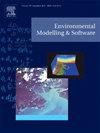STICr:用于流温度、间歇和电导率(STIC)数据的开源包和工作流程
IF 4.8
2区 环境科学与生态学
Q1 COMPUTER SCIENCE, INTERDISCIPLINARY APPLICATIONS
引用次数: 0
摘要
非多年生河流占世界河流里程的一半以上,但通常不包括在河流监测网络中。因此,流体温度、间歇性和导电性(STIC)记录仪被广泛用于表征非多年生流体的存在或不存在。为了促进“FAIR”(可查找、可访问、可互操作和可重用)流间歇科学,我们提出了一个开源R包,STICr,用于处理STIC记录器数据。STICr包括整理数据,校准传感器,将数据分类为湿/干读数,并执行质量检查和验证的功能。我们还展示了一个跨多个流域、年份和研究小组的跨学科项目的可重复的基于sticr的工作流程。在South Fork Kings Creek (Konza Prairie, Kansas, USA),我们发现河流的间歇性是由月降水输入、季节蒸散通量和底层地质之间的平衡驱动的。总体而言,STICr可用于创建FAIR溪流间歇数据,并促进水文和生态系统科学的进步。本文章由计算机程序翻译,如有差异,请以英文原文为准。

STICr: An open-source package and workflow for stream temperature, intermittency, and conductivity (STIC) data
Non-perennial streams constitute over half the world's stream miles but are not commonly included in streamflow monitoring networks. As a result, Stream Temperature, Intermittency, and Conductivity (STIC) loggers are widely used for characterizing flow presence or absence in non-perennial streams. To facilitate ‘FAIR’ (findable, accessible, interoperable, and reusable) stream intermittency science, we present an open-source R package, STICr, for processing STIC logger data. STICr includes functions to tidy data, calibrate sensors, classify data into wet/dry readings, and perform quality checks and validation. We also show a reproducible STICr-based workflow for an interdisciplinary project spanning multiple watersheds, years, and research groups. In South Fork Kings Creek (Konza Prairie, Kansas, USA), we show that stream intermittency is driven by the balance between monthly precipitation inputs, seasonal evapotranspiration fluxes, and underlying geology. Overall, STICr can be used to create FAIR stream intermittency data and enable advances in hydrologic and ecosystem science.
求助全文
通过发布文献求助,成功后即可免费获取论文全文。
去求助
来源期刊

Environmental Modelling & Software
工程技术-工程:环境
CiteScore
9.30
自引率
8.20%
发文量
241
审稿时长
60 days
期刊介绍:
Environmental Modelling & Software publishes contributions, in the form of research articles, reviews and short communications, on recent advances in environmental modelling and/or software. The aim is to improve our capacity to represent, understand, predict or manage the behaviour of environmental systems at all practical scales, and to communicate those improvements to a wide scientific and professional audience.
 求助内容:
求助内容: 应助结果提醒方式:
应助结果提醒方式:


